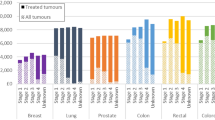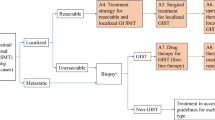Abstract
There are various registries for patients with peritoneal metastases (PM) that aid pooling of data and generate evidence that dictates current clinical practice. This manuscript describes the setting up of the Indian HIPEC registry that was set up with a similar goal by a group of Indian surgeons. This is a registry for patients with PM treated with CRS and HIPEC in India. It also acts as a database for storing treatment-related information. Patients with PM from colorectal ovarian, gastric, appendiceal tumors, and other rare peritoneal tumors/metastases from rare tumors are enrolled in the registry. A coordinator updates the disease status of patients on a yearly basis. A private organization maintains the database. A non-disclosure agreement is signed between the company and each surgeon contributing to the registry to maintain confidentiality. For enrolling patients, securing institutional permission depends on the requirement of each institute; patient consent is mandatory. Data entry can be prospective or retrospective. To propose and conduct a study, the approval of a scientific committee linked to the registry is required. The Indian HIPEC registry is a practical database for Indian surgeons. There is no regulatory body that mandates collection and publication of scientific data in India. The onus is on each surgeon to capture valuable information pertaining to these common and rare diseases that could contribute to the existing scientific knowledge and guide the treatment of these patients in the future. The next challenge will be to enter data into the registry.



Similar content being viewed by others
References
Esquivel J (2014) Current status and future directions of hyperthermic intraperitoneal chemotherapy (HIPEC). Intervent Oncol 360 2(6):E45–E52
Elias D, Goéré D, Dumont F, Honoré C, Dartigues P, Stoclin A, Malka D, Boige V, Ducreux M (2014 Jan) Role of hyperthermic intraoperative peritoneal chemotherapy in the management of peritoneal metastases. Eur J Cancer 50(2):332–340
Elias D, Gilly F, Boutitie F et al (2010) Peritoneal colorectal carcinomatosis treated with surgery and perioperative intraperitoneal chemotherapy: retrospective analysis of 523 patients from a multicentric French study. J Clin Oncol 28:63–68
Chua TC, Moran BJ, Sugarbaker PH et al (2012) Early- and long-term outcome data of patients with pseudomyxoma peritonei from appendiceal origin treated by a strategy of cytoreductive surgery and hyperthermic intraperitoneal chemotherapy. J Clin Oncol 30:2449–2456 [11]
Bhatt A, Mehta S, Seshadri RA, Sethna K, Zaveri S, Rajan F, Mahajan V, Singh S, Raj EH, Sugarbaker PH (2016) The initial Indian experience with cytoreductive surgery and HIPEC in the treatment of peritoneal metastases. Indian J Surg Oncol 7(2):160–165
Younger DS Health care in India. Neurol Clin 34(4):1103–1114
Bhojani U, Thriveni B, Devadasan R et al (2012) Out-of-pocket healthcare payments on chronic conditions impoverish urban poor in Bangalore, India. BMC Public Health 12:990. doi:10.1186/1471-2458-12-990
National Cancer Registry Programme (2001) Consolidated report of population based cancer registries 1990–96. WWW page. URL: http://www.ncrpindia.org/Annual_Reports.aspx. Last accessed 24 Feb 2016
National Cancer Registry Programme (2006) Consolidated report of population based cancer registries 2001–2004. WWW page. URL: http://www.ncrpindia.org/Annual Reports.aspx. Last accessed 24 Feb 2016
National Cancer Registry Programme (2015) WWW page. URL: http://ncrpindia.org. Last accessed 24 Feb 2016
Chatterjee S, Chattopadhyay A, Senapati SN, Samanta DR, Elliott L, Loomis D, Mery L, Panigrahi P (2016) Cancer registration in India—current scenario and future perspectives. Asian Pac J Cancer Prev 17(8):3687–3696
Jacquet P, Sugarbaker PH (1996) Clinical research methodologies in diagnosis and staging of patients with peritoneal carcinomatosis. Cancer Treat Res 82:359–374
Sugarbaker PH (2009) Epithelial appendiceal neoplasms. Cancer J 15:225–235
Author information
Authors and Affiliations
Corresponding author
Rights and permissions
About this article
Cite this article
Bhatt, A., Mehta, S., Ramakrishnan AS et al. Setting up of the Indian HIPEC Registry: A Registry for Indian Patients with Peritoneal Surface Malignancies. Indian J Surg Oncol 8, 527–532 (2017). https://doi.org/10.1007/s13193-017-0693-7
Received:
Accepted:
Published:
Issue Date:
DOI: https://doi.org/10.1007/s13193-017-0693-7




